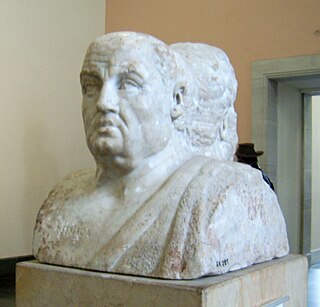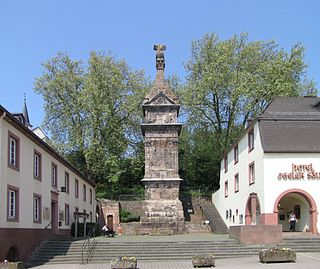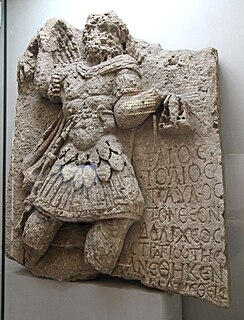 W
WThe Double Herm of Socrates and Seneca is an ancient Roman statue from the first half of the third century AD. The herm depicts the Greek philosopher Socrates on one side, and the Roman Stoic Seneca the Younger on the other. It currently belongs to the Antikensammlung Berlin, found in the Altes Museum.
 W
WThe Ludovisi Battle sarcophagus or "Great" Ludovisi sarcophagus is an ancient Roman sarcophagus dating to around AD 250–260, found in 1621 in the Vigna Bernusconi, a tomb near the Porta Tiburtina. It is also known as the Via Tiburtina Sarcophagus, though other sarcophagi have been found there. It is known for its densely populated, anti-classical composition of "writhing and highly emotive" Romans and Goths, and is an example of the battle scenes favored in Roman art during the Crisis of the Third Century. Discovered in 1621 and named for its first modern owner, Ludovico Ludovisi, the sarcophagus is now displayed at the Palazzo Altemps in Rome, part of the National Museum of Rome as of 1901.
 W
WThe Igel Column is a multi-storeyed Roman sandstone column in the municipality of Igel, Trier, Germany, dated to c. 250 AD. The column is the burial monument of the Secundinii cloth merchant family.
 W
WA Jupiter Column is an archaeological monument belonging to a type widespread in Roman Germania.
 W
WThe sarcophagus with hunting scenes, known as Mattei I, is an ancient Roman sarcophagus of the 3rd century, displayed at the palazzo Mattei in Rome. It is 1.31m high.
 W
WThe Portrait of the Four Tetrarchs is a porphyry sculpture group of four Roman emperors dating from around 300 AD. The sculptural group has been fixed to a corner of the façade of St Mark's Basilica in Venice, Italy since the Middle Ages. It probably formed part of the decorations of the Philadelphion in Constantinople, and was removed to Venice in 1204 or soon after.
 W
WThe Sarcophagus of the Triumph of Bacchus is a monumental ancient Roman stone sarcophagus of Carrara marble. The style and high quality of its reliefs and the choice of Bacchus triumphing over India as its subject suggests it came from a Roman workshop and possibly dates to the start of the 3rd century, from the reign of Caracalla to that of Elagabalus. It was rediscovered around 1800 on the Saint-Just hill in Lyon, France, during the rebuilding of the église Saint-Irénée. At that time it was broken into three pieces and reburied 4m below the church's staircase, from where it was exhumed in 1824 by A. Comarmond during restoration work on the church. It is now in the Gallo-Roman Museum of Lyon.
 W
WThe Votive relief of Jupiter Dolichenus was discovered in the ancient city of Perrhe in the kingdom of Commagene in the southeast of modern Turkey. It is now displayed in the Adıyaman Archaeological Museum.